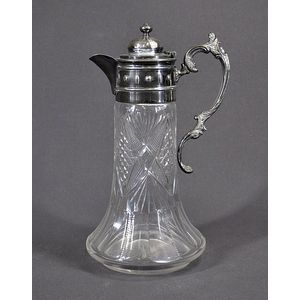German Rococo Silver Tankard with Spherical Finial
Large late 19th century German silver lidded tankard, impressed German silver marks to base, with spherical finial, above embossed rococo decoration, with branched thumb rest and c-scroll handle, on spreading circular foot, total weight 717gm, height 20.5 cm
You must be a subscriber, and be logged in to view price and dealer details.
Subscribe Now to view actual auction price for this item
When you subscribe, you have the option of setting the currency in which to display prices to $Au, $US, $NZ or Stg.
This item has been sold, and the description, image and price are for reference purposes only.
- Embossed / Repousse - Embossing, also known as repousse, is the technique of decorating metal with raised designs, by pressing or beating out the design from the reverse side of the object.It is the opposite of chasing, where the decoration is applied from the front. An embossed or repoussed object may have chasing applied to finish off the design.
- Finial - An architectural decoration, found on the upper parts of of an object. On furniture they are usually found on pediments, canopies and shelf supports. On smaller ceramic or silver items, such as spoons, they may decorate the top of the item itself, or the lid or cover where they provide a useful handle for removal.
Finials have a variety of shapes and forms. They may be urn-shaped, baluster shaped round or spiral, but usually taper into an upper point. Many real life shapes may also be used as finials, such as pineapples, berries, pinecones, buds, lotus and acorns. Sometimes animals such as a lion are depicted, or fish and dolphins. - Tankard - A tankard is a drinking vessel for beer, ale, and cider, similar in shape to a large mug, and usually with a hinged lid. Silver tankards were in use in Britain and other parts of Europe from at least the sixteenth century, pewter tankards probably from the thirteenth. In the 19th century a number of ornately carved ivory tankards were produced, but these were designed to demonstrate the skill of the carver, rather than for day to day use. The shapes of tankards vary, sometimes globular, sometimes a tapering concave. For those with lids, the lid usually includes a thumbpiece that the drinker can hold down to keep the lid open. Variation in the design of the thumbpiece include wedge, ball and wedge, ball, hammer head, bud and wedge, double volute (scroll), chair-back, ball and bar, shell, double acorn, corkscrew, and ram's horn.
This item has been included into following indexes:
Visually similar items

A George II sterling silver mug, London 1745
Sold by
in
for
You can display prices in $Au, $US, $NZ or Stg.

Four piece George V sterling silver teaset comprising of coffee pot, teapot, sugar and creamer, hallmarked Birmingham 1928, maker: Adie Brothers Ltd, 1437 grams
Sold by
in
for
You can display prices in $Au, $US, $NZ or Stg.

Early silver plated crystal claret jug. Height 29 cm
Sold by
in
for
You can display prices in $Au, $US, $NZ or Stg.

Late Victorian silver plated bachelor teaset, comprising of teapot (2 cm high), jug & sugar bowl
Sold by
in
for
You can display prices in $Au, $US, $NZ or Stg.
